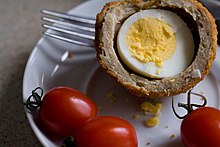 Scotch egg, halved | |
| Type | Picnic food |
|---|---|
| Place of origin | England |
| Main ingredients | Boiled egg, sausage, bread crumbs |
A Scotch egg is a boiled egg wrapped in sausage meat, coated in breadcrumbs and baked or deep-fried.
 Scotch egg, halved | |
| Type | Picnic food |
|---|---|
| Place of origin | England |
| Main ingredients | Boiled egg, sausage, bread crumbs |
A Scotch egg is a boiled egg wrapped in sausage meat, coated in breadcrumbs and baked or deep-fried.
Various origin stories exist. The Oxford Companion to Food gives the first instance of the name as of 1809, in an edition of Maria Rundell's A New System of Domestic Cookery. [1] They did not, at that time, have a breadcrumb layer, although by 1861 Isabella Beeton suggested this as an option. [1] According to the Oxford Companion to Food, food historian Annette Hope speculated in 1987 that the inspiration may have been Indian koftas [1] such as the Mughlai dish called nargisi kofta ("Narcissus meatballs"), in which a boiled egg is encased in a seasoned ground-meat mixture and then fried. [2]
Other claims include the item having been invented at Fortnums. [3] According to Culinary Delights of Yorkshire, they originated in Whitby, Yorkshire, England, in the 19th century, and were originally covered in fish paste rather than sausage meat. They were supposedly named after William J. Scott & Sons, a well-known eatery which sold them. [4]
It has also been suggested that they were originally called "scorch" eggs, as they were cooked over an open flame, though according to surviving recipes they were deep-fried in lard. 'Scotching' as a culinary process is also sometimes cited as the origin, though what 'scotching' was is open to interpretation, from the inclusion of anchovies to simply mincing meat. [5] Further confusion is added by the large trade in eggs from Scotland in the 19th century, which sometimes involved dipping eggs in a lime powder to preserve them, a process possibly also known as 'scotching'. [6]
Scotch eggs are prepared by hard- or soft-boiling an egg, wrapping it in sausage meat, and deep-frying it. [1] It is often eaten in pubs or as a cold snack at picnics. [1]

In the Netherlands and Belgium, Scotch eggs may also be called vogelnestje ("little bird's nest"), because they contain an egg. One 1880s Scottish recipe also calls them birds' nests. [6]
The Manchester egg consists of a pickled egg wrapped in a mixture of pork meat and Lancashire black pudding. [7]
Vegetarian versions have also been made. In 2022, Guinness World Records certified a 18.341 kilograms (40.43 lb) vegetarian scotch egg as the world's largest. [8] [9] It used an ostrich egg in the center, with a coating made of peas and cheddar cheese. [8] [10] The Harwood Arms, a Michelin-starred restaurant in London, started selling a vegetarian scotch egg that uses a plant-based meat alternative in 2020, [11] and the next year, the supermarket chain Tesco started selling a vegan version. [12]
A fatty food, [13] a typical sausage-coated Scotch egg has about 200 mg dietary cholesterol per 100 grams. [14]

Haggis is a savoury pudding containing sheep's pluck, minced with chopped onion, oatmeal, suet, spices, and salt, mixed with stock, and cooked while traditionally encased in the animal's stomach though now an artificial casing is often used instead. According to the 2001 English edition of the Larousse Gastronomique: "Although its description is not immediately appealing, haggis has an excellent nutty texture and delicious savoury flavour".

A sausage is a type of meat product usually made from ground meat—often pork, beef, or poultry—along with salt, spices and other flavourings. Other ingredients, such as grains or breadcrumbs, may be included as fillers or extenders.

Gravy is a sauce often made from the juices of meats that run naturally during cooking and often thickened with corn starch or other thickeners for added texture. The gravy may be further coloured and flavoured with gravy salt or gravy browning or ready-made cubes. Powders can be used as a substitute for natural meat or vegetable extracts. Canned and instant gravies are also available. Gravy is commonly served with roasts, meatloaf, rice, noodles, chips (fries), mashed potatoes, or biscuits.

Meatloaf is a dish of ground meat that has been combined with other ingredients and formed into the shape of a loaf, then baked or smoked. The final shape is either hand-formed on a baking tray, or pan-formed by cooking it in a loaf pan. It is usually made with ground beef, although ground lamb, pork, veal, venison, poultry, and seafood are also used, sometimes in combination. Vegetarian adaptations of meatloaf may use imitation meat or pulses.

Toad in the hole is a traditional English dish consisting of sausages in Yorkshire pudding batter, usually served with onion gravy and vegetables. Historically, the dish has also been prepared using other meats, such as rump steak and lamb's kidney. In the 21st century, vegetarian and vegan versions have appeared.

White pudding, oatmeal pudding or mealy pudding is a meat dish popular in the British Isles.
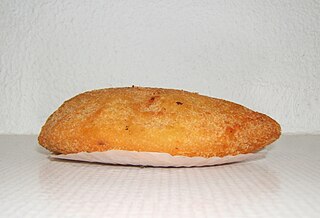
A rissole is a small patty enclosed in pastry or rolled in breadcrumbs, usually baked or deep fried. The filling has savory ingredients, most often minced meat, fish or cheese, and is served as an entrée, main course, or side dish.
Romanian cuisine is a diverse blend of different dishes from several traditions with which it has come into contact, but it also maintains its own character. It has been mainly influenced by Turkish but also a series of European cuisines in particular from the Balkan Peninsula and Hungarian cuisine as well as culinary elements stemming from the cuisines of Central Europe.

Kofta is a family of meatball or meatloaf dishes found in Balkan, Middle Eastern, North African, South Caucasian, South Asian and Central Asian cuisines. In the simplest form, koftas consist of balls of minced meat – usually beef, chicken, pork, lamb or mutton, or a mixture – mixed with spices and sometimes other ingredients. The earliest known recipes are found in early Arab cookbooks and call for ground lamb.

Glamorgan sausage is a traditional Welsh vegetarian sausage for which the main ingredients are cheese, leeks and breadcrumbs. It is named after the historic county of Glamorgan in Wales.
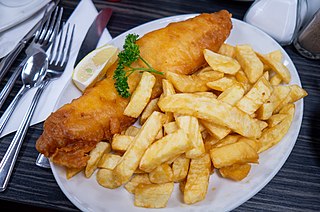
British cuisine is the specific set of cooking traditions and practices associated with the United Kingdom, including the cuisines of England, Scotland, Wales and Northern Ireland. According to food writer Colin Spencer, historically, British cuisine meant "unfussy dishes made with quality local ingredients, matched with simple sauces to accentuate flavour, rather than disguise it".
Culinary names, menu names, or kitchen names are names of foods used in the preparation or selling of food, as opposed to their names in agriculture or in scientific nomenclature. The menu name may even be different from the kitchen name. For example, from the 19th until the mid-20th century, many restaurant menus were written in French and not in the local language.

A full breakfast is a substantial cooked breakfast meal, often served in Great Britain and Ireland. The typical ingredients are bacon, sausages, eggs, black pudding, baked beans, tomatoes, mushrooms, toast, fried bread and a beverage such as coffee or tea. Hash browns are a common contemporary but non-traditional inclusion. Ingredients may extend beyond these or include regional variants, which may often be referred to by different names depending on the area. While it is colloquially known as a "fry-up" in most areas of the United Kingdom and Ireland, it is usually referred to as a "full English", a "full Irish", "full Scottish", "full Welsh", and "Ulster fry", in England, the Republic of Ireland, Scotland, Wales, and Northern Ireland, respectively.

A meatball is ground meat (mince) rolled into a ball, sometimes along with other ingredients, such as bread crumbs, minced onion, eggs, butter, and seasoning. Meatballs are cooked by frying, baking, steaming, or braising in sauce. There are many types of meatballs using different types of meats and spices. The term is sometimes extended to meatless versions based on vegetables or fish; the latter are also commonly known as fish balls.

Northern Irish cuisine encompasses the cooking styles, traditions and recipes associated with Northern Ireland. It has distinctive attributes of its own, but has also drawn heavily from Irish and British cuisines.

Black pudding is a distinct regional type of blood sausage originating in the United Kingdom and Ireland. It is made from pork or occasionally beef blood, with pork fat or beef suet, and a cereal, usually oatmeal, oat groats, or barley groats. The high proportion of cereal, along with the use of certain herbs such as pennyroyal, serves to distinguish black pudding from blood sausages eaten in other parts of the world.
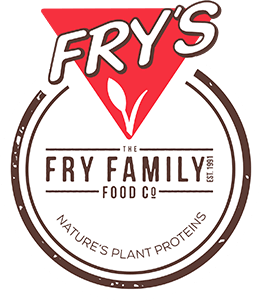
Fry Group Foods is a manufacturer of vegan meat substitutes founded by South Africans Wally and Debbie Fry in 1991. In March 2020 it joined LIVEKINDLY Collective, the global plant-based food company.
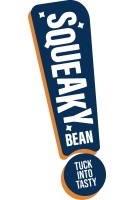
Squeaky Bean is a British vegan food company and began trading in 2019. It is owned by the British food manufacture company Winterbotham Darby and is based in Redhill, Surrey, United Kingdom. The company experienced rapid expansion from just three products into a multiproduct brand stocked in British supermarkets. The brand significantly expanded its distribution capabilities following the growth and receiving millions of pounds worth of investment. In 2021, it was reported that the brand had amassed a turnover of £7.5 million.
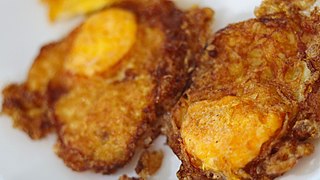
A deep fried egg is an egg dish consisting of an egg that has been deep fried. Sometimes the dish is prepared only using the egg yolk, which is referred to as deep fried egg yolk. Various types of eggs can be used, such as chicken, duck and quail eggs. The dish is sometimes served alone, and is also used as an ingredient for various dishes. Sometimes also pre-cooked eggs are breaded and deep fried.